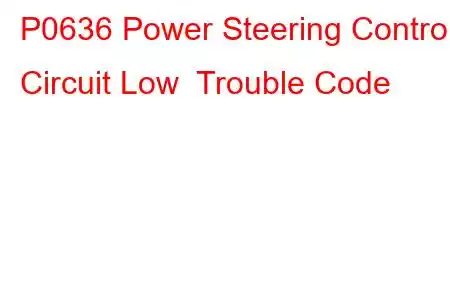P0636 Power Steering Control Circuit Low
OBD-II Trouble Code Technical Description
Power Steering Control Circuit Low
What does that mean?
This is a generic powertrain diagnostic trouble code (DTC) and applies to many OBD-II vehicles (1996-newer). That may include but is not limited to vehicles from Saturn, Renault, Dodge, Ford, Nissan, Mercedes, etc. Although generic, the exact repair steps may vary depending on year, make, model and powertrain configuration.
OBD-II trouble codes P0635, P0636, and P0637 are associated with the power steering control circuit.
When the Power Control Module (PCM) detects too low of voltage signals within the power steering control circuit code P0636 will be set and the check engine light will be illuminated.
The purpose of the power steering control circuit is to provide the appropriate voltage to various power steering components. The PCM monitors voltage signals from the power steering controller, sensors and switches. These components provide the proper fluid pressure within the power steering system. This process is essential to prevent damage to power steering components. The power steering control circuit facilitates the power steering system to adapt to various driving conditions and prevent Stiff or erratic steering. This circuit alerts the PCM that possible issues exist that require immediate attention.
An electric power steering motor:
What is the severity of this DTC?
The severity of this code can vary tremendously from just an illuminated check engine light on a vehicle that operates normally to a stiff or erratic steering issue. Steering problems can become a safety issue when not given immediate attention.
What are some of the symptoms of the code?
Symptoms of a P0636 trouble code may include:
Stiff or erratic steering Noise while turning Check engine light illuminatedWhat are some of the common causes of the code?
Causes for this P0636 code may include:
Defective power steering pressure switch Defective power steering position switch Faulty power steering control A loose control module ground strap or broken ground wire Insufficient fluid level or leak Blown fuse or fuse-able link (if applicable) Corroded or damaged connector Faulty or damaged wiring Defective PCMWhat are some P0636 troubleshooting steps?
The first step in the troubleshooting process for any malfunction is to research the Technical Service Bulletins (TSB's) for the specific vehicle by year, model and power plant. In some circumstances this can save a lot of time in the long run by pointing you in the right direction.
The second step is to check the power steering fluid level and look for possible leaks that would have a negative impact on the pressure supplied to the power steering controller and associated components. The proper fluid pressure plays a key role in the function of this circuit. Then locate all of the components within this circuit and perform a thorough visual inspection to check the associated wiring for obvious defects such as scraping, rubbing, bare wires, or burn spots. Next is to check the connectors for security, corrosion and damaged pins. This process must include the power steering controller, associated sensors, switches and the PCM. The condition of the Controller Area Network (CAN) is essential to this troubleshooting process because a damaged wiring harness makes it very difficult to pinpoint defective components.
Advanced Steps
The advanced steps become very vehicle specific and require the appropriate advanced equipment to perform accurately. These procedures require a digital multi meter and the specific technical references for the vehicle. Voltage requirements will vary based on the specific year and model of the vehicle.
Voltage Checks
Specific troubleshooting guidelines must be reference
Read: 41


